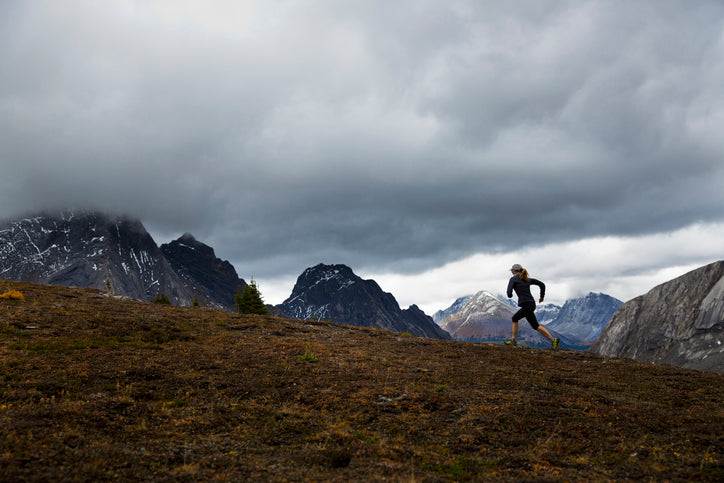Ask any endurance athlete what the core part of their training and season might be comprised of, and they'll undoubtedly tell you that high-altitude running has been an essential part of their routine. But why? What's the benefit of high-altitude running, and why should you challenge yourself by trying?
The Theory
Scientists and couches have been using altitude training for many years to help increase their athlete's endurance. The theory behind altitude training is that the oxygen inhaled from the air people breathe is the energy their muscles receive to perform physical activities. Oxygen is carried around the body via red blood cells and helps the molecules in muscles function. The higher the altitude, the lower the atmospheric pressure, which makes it harder for the body to transfer oxygen into the blood. This is why many people feel lethargic at higher altitudes.
Responding to the difficulty of transferring oxygen, the brain triggers an increase in the production of a hormone called erythropoietin, or EPO. The increased output of EPO results in the body making more red blood cells to transport oxygen, resulting in the body eventually transporting the limited oxygen better than when it first arrived at higher altitudes.
In short, your body produces more red blood cells to compensate for the high altitude. More red blood cells mean your body can carry more oxygen, which is more efficient for working muscles.
Endurance athletes often train at high altitudes, then return to sea level with increased red blood cells better able to transport oxygen than before, increasing an athlete's aerobic capacity. Of course, the body will, over time, return to normal levels of red blood cell production if the process is not repeated and maintained.
The time it takes for this to happen varies from one athlete to the next. A professional athlete will have far more resources, such as the time to hide away in the mountains and run. They can spend up to 21-28 days on the mountain and return to sea level. But what about the rest of us who can't spend a month or two on a mountain or high altitude?
What You Need to Know Before Running
Before you book a ticket off somewhere for the hills, it's essential to understand a few things about the unique challenges of trying to run at higher altitudes when you've never done so before.
It's important to understand that if you've never trained or run before and have lived at base sea level your entire life—you shouldn't be starting your journey at a higher altitude. It would help if you had a strong foundation of an already established running and training routine at sea level.
Remember that the effects of being at high altitude can vary significantly from person to person. Some people are lucky because they experience little to no consequences, while others can experience moderate to severe responses that may need hospital attention when training at high altitudes.
Don't make the mistake of training too hard, too soon, as soon as you arrive at a place of high elevation. The risk of altitude sickness is generally very high. Anytime you go above 8,000 feet, you can risk altitude sickness.
There are three levels of altitude sickness:
1. Acute mountain sickness. This is the mildest form and most common. The symptoms are lethargy, dizziness, headaches, muscle aches, and nausea.
2. High-altitude pulmonary edema (HAPE). HAPE is a build-up of fluid in the lungs that can be very dangerous and life-threatening. This is the most common cause of death from altitude sickness.
3. High-altitude cerebral edema (HACE.) HACE is the most severe form and happens when there is fluid in the brain. It, too, is life-threatening and needs medical attention right away.
Symptoms Include:
• Headache
• Nausea
• Vomiting
• Fatigue and loss of energy
• Shortness of breath
• Problems with sleep
• Loss of appetite
Easing Into High Altitude
The best strategy to transition into high-altitude running varies, such as the time you have to adjust, your age, and your fitness level. Where you've been training before arriving in a higher-altitude area, weather conditions, and your goals all matter, but some general techniques can help ease you in.
1. Time
It would be best if you gave yourself as long of a transition period as possible to help ensure acclimation successfully. This may not always be possible, but the recommended time is for 3 weeks. This allows your body to adjust gradually.
2. Proper Nutrition and Hydration
Proper nutrition and hydration are critical in making the adjustment period easier. High-altitude training should strongly emphasize hydration as the dry air can quickly drain your body of moisture. Water is essential to enabling red blood cells to circulate oxygen in the lungs. It would be best if you doubled your hydration intake. A low-fat diet when training at altitude is recommended, as there's growing evidence the body doesn't digest fat as efficiently at higher elevations.
3. Don't Rush.
Go slow. Gradually transition upward via 1,000-foot increments instead of trying to conquer it all at once. You'll have much better results.
4. Avoid smoking or consuming alcohol.
Both have been linked to increasingly strained breathing at high altitudes.
What If There's No Mountain?
Whether you live too far away or it isn't in your budget, there are ways that you can train and challenge yourself as if you were high-altitude running without the altitude. The training is called Hypoxic training and is also known as 'breath hold training." The basics of this training are reducing the amount of oxygen you take in when you run. It is the closest thing you can get to altitude running without being there—and the best part? It's free.
1. Take 3-5 normal breaths in and out through the nose. Exhale on the last breath and hold while on your run. Hold until you feel a medium to a solid urge to breathe.
2. Breathe in when you need to. The first breath will be larger than usual.
3. Take 3-5 breaths before the next exhale and repeat steps 1 and 2.
4. Repeat the cycle for 10-15 minutes.
While doing any of these, you are paying attention to your body and self-talk. How are you feeling? What's your emotional state? How are you reacting? Does anything hurt? If you have any medical condition, especially related to breathing, make sure you get medical clearance before trying anything above.
We hope you've enjoyed our tips and tricks on challenging yourself with high-altitude running! We hope you have a great time, enjoy conquering a difficult task and bask in the after-glow of success!







Leave a comment
This site is protected by hCaptcha and the hCaptcha Privacy Policy and Terms of Service apply.